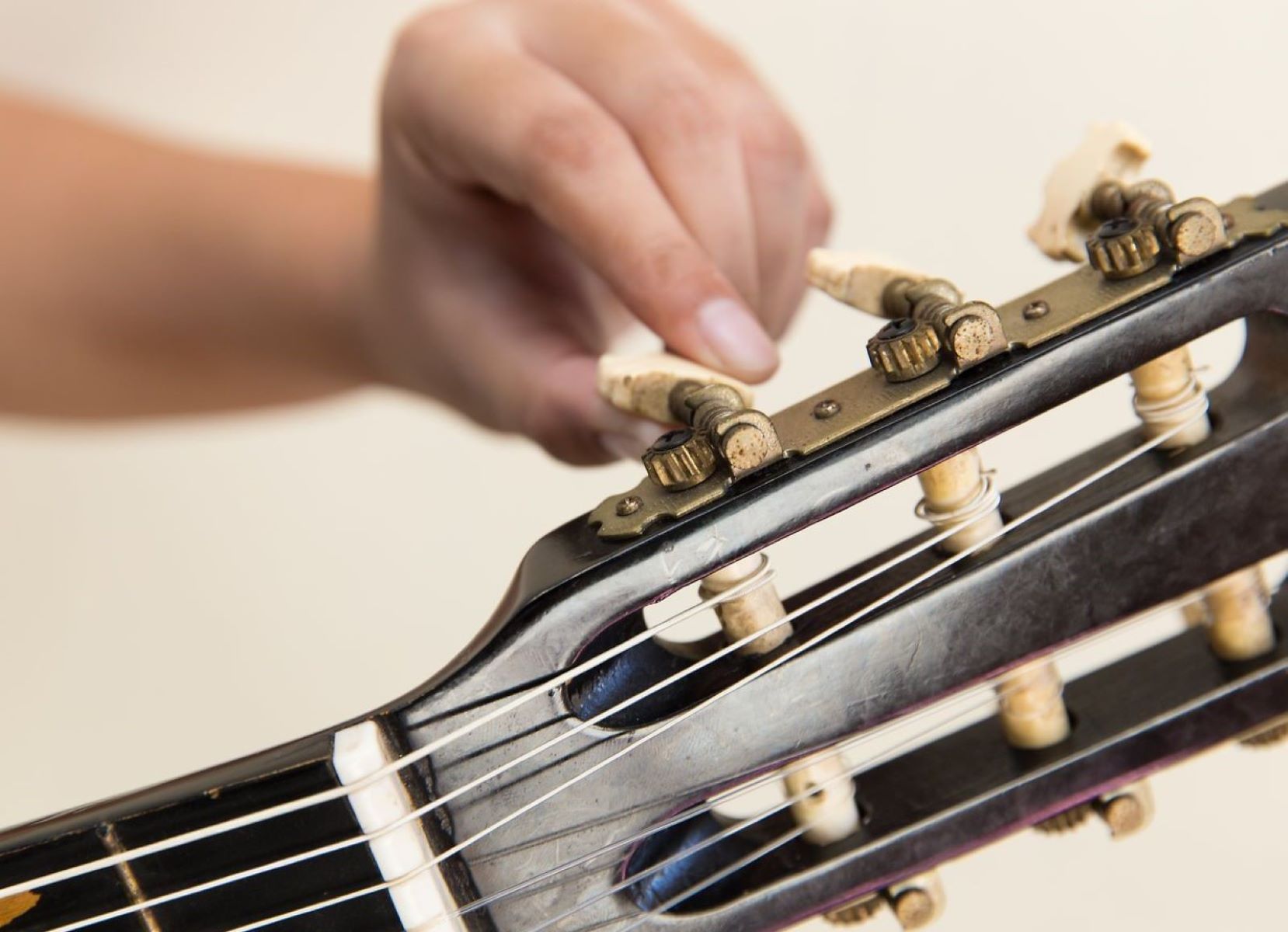

Folk
How To Restring A Folk Guitar
Modified: February 15, 2024
Learn how to restring your folk guitar with step-by-step instructions and expert tips. Keep your folk instrument in top shape and ensure optimal sound quality.
(Many of the links in this article redirect to a specific reviewed product. Your purchase of these products through affiliate links helps to generate commission for AudioLover.com, at no extra cost. Learn more)
Table of Contents
Introduction
Welcome to the wonderful world of folk guitar! As a folk musician, one of the essential skills you need to acquire is knowing how to restring your guitar. Regularly changing your guitar strings is crucial for maintaining the best sound quality and playability of your instrument.
In this comprehensive guide, we will walk you through the step-by-step process of restringing your folk guitar. By following these instructions, you’ll be able to keep your guitar in optimal condition and ensure that it continues to produce that beautiful, resonant folk sound.
Restringing a folk guitar may seem like a daunting task, especially if you’re a beginner. However, with a little patience and practice, you’ll become adept at this routine maintenance procedure. Not only will you gain confidence in handling your instrument, but you’ll also save money by avoiding costly trips to a guitar shop.
Before we delve into the specifics of restringing, it’s important to note that the techniques described in this guide are applicable to most types of folk guitars, including acoustic, classical, and electric-acoustic guitars. Additionally, we will assume that you have a basic understanding of guitar anatomy, such as identifying the bridge, tuning pegs, and nut.
Are you ready to dive into the world of folk guitar stringing? Let’s get started by gathering the necessary tools and materials!
Gathering the Necessary Tools and Materials
Before you begin the restringing process, it’s essential to gather all the necessary tools and materials. Having everything prepared will make the task more efficient and ensure a smooth restringing experience. Here’s what you’ll need:
- New Guitar Strings: Ensure you have a set of guitar strings specifically designed for your folk guitar. Different guitars require different string gauges, so make sure to choose the appropriate ones. You can find a wide selection of folk guitar strings at your local music store or online.
- String Cutter: A good pair of wire cutters or dedicated string cutters will make trimming the excess string length much easier. Make sure they are sharp and capable of cutting through guitar strings cleanly.
- Guitar Tuner: To ensure your strings are perfectly in tune, you’ll need a reliable guitar tuner. There are various types of tuners available, including clip-on tuners, handheld tuners, or smartphone apps.
- Guitar Polish and Cloth: While not necessary for restringing, having guitar polish and a soft cloth can be useful for cleaning and maintaining your instrument’s appearance.
- Guitar Rest or Neck Support: It’s important to have a comfortable and stable surface to rest your guitar on during the restringing process. A guitar rest or neck support will help you keep the guitar steady while you work on it.
- String Winder: While not essential, a string winder can save you a significant amount of time and effort when loosening and tightening your guitar strings. This tool attaches to the tuning pegs and allows you to wind the strings quickly and smoothly.
Once you’ve gathered all the necessary tools and materials, you’ll be well-prepared to start the restringing process. Having everything at hand will prevent any unnecessary delays or interruptions, allowing you to restring your guitar efficiently.
Removing the Old Strings
Now that you have all the required tools and materials, it’s time to begin the restringing process by removing the old strings from your folk guitar. Follow these steps to safely and effectively remove the old strings:
- Loosen the strings: Start by loosening the tuning pegs to relieve tension on the strings. Use either your fingers or a string winder to turn the pegs counterclockwise. This will decrease the tension on the strings and make them easier to remove.
- Trim the excess: Once the strings are sufficiently loose, use your string cutter to trim the excess string length near the bridge. Be cautious when cutting the strings to avoid accidentally scratching your guitar’s finish.
- Unwind the strings: Begin unwinding each string from the tuning pegs. Use your fingers or a string winder to turn the pegs clockwise, gradually unwinding the strings until they are completely removed from the pegs. Be careful not to let the strings whip around and potentially harm you or your guitar.
- Remove the bridge pins (if applicable): If your folk guitar has bridge pins holding the strings in place, gently remove them using a bridge pin puller or a pair of pliers. Take caution not to damage the bridge or the pins during this process. Some guitars may not have bridge pins and instead have a different type of bridge, so ensure you are familiar with your specific guitar’s design.
- Clean the guitar: With the old strings removed, take a moment to clean your guitar. Use a soft cloth to wipe away any dirt or debris that may have accumulated around the bridge area or on the fretboard.
By following these steps, you have successfully removed the old strings from your folk guitar. Now it’s time to move on to the next step: preparing the new strings.
Preparing the New Strings
With the old strings removed, it’s time to prepare the new strings for restringing your folk guitar. Proper preparation will ensure that the strings are ready to be installed and will result in optimal sound and playability. Follow these steps to prepare the new strings:
- Inspect the new strings: Before proceeding, carefully inspect each new string for any defects or imperfections. Look for any kinks, bends, or blemishes that could affect their performance. If you notice any issues, it’s best to replace the affected string with a new one.
- Stretch the strings: To minimize the amount of stretching and settling the strings will do after installation, gently stretch each individual string before restringing. Hold the string firmly at both ends and apply light, even pressure along its length. This will help ensure better tuning stability once the strings are installed.
- Identify the correct string: Different guitars have different string orders and gauges. Ensure that you are selecting the correct string for each position on your folk guitar. Most string sets will label their packages with the string position (e.g., 1st, 2nd, 3rd) and the string gauge, making it easier for you to identify and organize them correctly.
- Insert the ball end (if applicable): If your folk guitar has a bridge with holes through which the strings are anchored, carefully insert the ball end of each string into the corresponding hole. Make sure the ball end is securely seated and not protruding from the bridge.
- Attach the bridge pins (if applicable): If your guitar uses bridge pins, insert the end of each string into its respective bridge pin hole. Gently press the bridge pins into place, ensuring they are properly seated and holding the string securely.
- Leave slack at the headstock: With the other end of the strings, bring them up and over the bridge towards the headstock of your guitar. Leave enough slack so that you can wind the strings around the tuning pegs without causing excessive tension.
By following these steps, you have properly prepared the new strings for restringing your folk guitar. Now it’s time to move on to the next section and learn how to restring your guitar properly.
Restringing the Guitar
Now that you have prepared the new strings, it’s time to restring your folk guitar. Follow these steps to properly install the new strings:
- Starting with the low E string: Begin by threading the end of the low E string (thickest string) through the appropriate hole in the tuning peg. Leave a few inches of slack to work with.
- Securing the string: Use your hand to hold the string in place against the nut while you turn the tuning peg clockwise with your other hand. Wind the string around the peg, making sure the wraps are neat and tight. Aim for 2-3 wraps for the wound strings and 4-5 wraps for the plain strings.
- Guiding the string: As you wind the string, guide it towards the low end of the headstock, ensuring that it sits snugly in the nut slot. This will help keep the string in position and improve tuning stability.
- Repeat for the remaining strings: Repeat steps 1-3 for each of the remaining strings, working your way from the A string, D string, G string, B string, and finally the high E string (thinnest string). Make sure to leave enough slack when initially threading each string and wind them neatly around their respective tuning pegs.
- Tightening the strings: Once all the strings are attached and wound around the tuning pegs, begin tightening them to their desired pitch. Use a guitar tuner to ensure accurate tuning and gradually increase the tension by turning the tuning pegs clockwise. Take your time to avoid over-tightening or breaking the strings.
- Eliminating excess string length: Once all the strings are in tune, use your string cutter to trim the excess length near the tuning pegs. Ensure that you leave a reasonable amount of slack to allow for future adjustments.
By following these steps, you have successfully restringed your folk guitar. However, the process doesn’t end here. Next, we will discuss how to tune your newly restringed guitar to bring out its best sound.
Tuning the Guitar
Now that you have restringed your folk guitar, it’s crucial to tune it before you can start playing. Tuning ensures that your guitar is in the correct pitch, allowing you to create harmonious chords and melodies. Follow these steps to tune your folk guitar:
- Use a reliable tuner: Whether you’re using a clip-on tuner, handheld tuner, or a tuner app on your smartphone, make sure it’s accurate and calibrated correctly.
- Start with the low E string: Begin by plucking the low E string (the thickest one), and observe the tuner’s display. If the tuner shows that the pitch is too low, tighten the string by turning the tuning peg clockwise. If it’s too high, loosen the string by turning the peg counterclockwise. Continue adjusting until the tuner indicates that the string is in tune.
- Move to the A string: Repeat the process for the A string, plucking it and adjusting the tension until it matches the correct pitch.
- Tune the remaining strings: Follow the same procedure for each of the remaining strings, moving from the D string to the G string, B string, and finally the high E string. Take your time and make small adjustments to ensure each string is tuned accurately.
- Check for overall pitch: Once all the strings are individually tuned, strum all the strings together to check for overall pitch and harmony. Listen for any dissonance or out-of-tune notes and make small adjustments as necessary.
Remember, tuning your guitar is an ongoing process. It’s normal for strings to slightly go out of tune due to factors like temperature, humidity, and playing. Regularly check the tuning of your guitar and make adjustments as needed to maintain optimal sound quality.
Now that your guitar is in tune, it’s time to move on to the final steps and take precautions to ensure the longevity of your instrument and strings.
Final Steps and Precautions
Congratulations! You have successfully restringed and tuned your folk guitar. Before you start playing, there are a few final steps and precautions you should take to ensure the longevity of your instrument and strings:
- Check the string height: After restringing, it’s a good idea to check the action or string height of your guitar. If the strings are too high off the fretboard, it may be more difficult to play. Conversely, if they are too low, you may experience buzzing. Adjust the truss rod or consult a professional if necessary.
- Stretch the strings again: After restringing, it’s common for the new strings to stretch and settle. To expedite this process, gently tug on each string, applying light pressure to help them settle more quickly. Retune the guitar afterward to ensure accuracy.
- Wipe down the guitar: Take a soft cloth and wipe down your guitar to remove any fingerprints, oil, or debris that may have accumulated during the restringing process. This will help keep your guitar looking clean and ensure that the finish stays in good condition.
- Be mindful of humidity and temperature: Changes in humidity and temperature can affect the stability and playability of your guitar. Store your guitar in a controlled environment and use a humidifier or dehumidifier if necessary. Extreme conditions can cause the guitar to warp or damage the strings.
- Regularly clean and maintain your guitar: A well-maintained guitar will not only sound better but will also prolong its lifespan. Clean the fretboard, polish the body, and lubricate the tuners periodically. Consult the manufacturer’s recommendations for specific cleaning and maintenance guidelines.
- Replace strings regularly: Even with proper care, guitar strings will eventually lose their tone and intonation. It’s recommended to replace them every few months or sooner if they become excessively worn, corroded, or break.
By following these final steps and taking necessary precautions, you will ensure that your newly restrung folk guitar remains in optimal playing condition. Now, it’s time to pick up your instrument, strum those new strings, and let the music flow!
Conclusion
Congratulations on successfully restringing your folk guitar! By following the step-by-step process outlined in this guide, you have gained a valuable skill that will help you maintain the best sound quality and playability of your instrument. Restringing your guitar regularly is essential for any folk musician, as it ensures that your guitar produces that beautiful, resonant sound that is characteristic of the genre.
Throughout this guide, we covered everything from gathering the necessary tools and materials to removing the old strings, preparing the new strings, restringing the guitar, tuning it, and taking final steps and precautions for optimum performance. By following these instructions, you have not only saved money on trips to the guitar shop, but you have also gained confidence in handling and maintaining your own guitar.
Remember, proper maintenance and care are key to keeping your guitar in excellent condition. Regularly cleaning your guitar, monitoring humidity levels, and replacing strings when necessary will ensure that your instrument continues to produce the best sound possible.
Now that you’re armed with the knowledge and skills to restring your folk guitar, go ahead and explore the vast world of folk music. Experiment with different melodies, chord progressions, and fingerpicking styles to truly bring out the soulful and captivating nature of this genre.
So pick up your guitar, strum those new strings, and let the enchanting sounds of folk music fill the air. Enjoy your musical journey!











